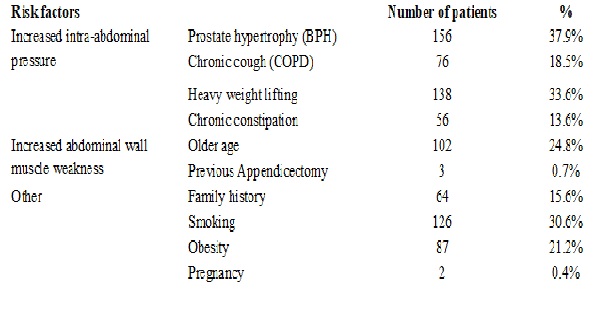Demographic study in operated patients with inguinal hernia
Abstract
Background: Inguinal hernia is most common anterior abdominal wall hernia and affects all ages with male predominance.The main cause of inguinal hernia is increased abdominal pressure and muscle weakness of abdominal wall. Diagnosis of inguinal hernia is mostly made by clinical examination. Herniotomy, herniorrhaphy, hernioplasty by open operation and laparoscopic procedures is the operative treatment.
Material and Method: This retrospective study was conducted in the department of surgery in J.K. Hospital in 411 operated patients with diagnosis of inguinal hernia.
Results: Highest number of patients belongs to 41-60 years age group (42.8%). 94.6 % were male and 5.3 % were female patients. Risk factors included benign prostate hypertrophy (37.9%), chronic cough (18.5%), heavy weight lifting (33.6%), chronic constipation (13.6%), abdominal wall muscle weakness due to older age (24.8%) & previous appendicectomy (0.7%). Less common risk factors are positive family history (15.6%), smoking (30.6%), obesity (21.2%) and pregnancy (0.4%). 69.8% patients presented as indirect, 28.2% as direct inguinal hernia and 1.2% as both variety. 67.6% patient presented as right inguinal hernia followed by left (29.2%) and bilateral (3.2%) respectively. Elective operation (94.4%) is more common than emergency operation (5.6%).Open hernioplasty (96.6%) was the most common procedure. Open herniorrhaphy was performed in few patient (2.7%). Open herniotomy was procedure of choice for paediatric patients (0.7%).
Conclusion: This demographic study of inguinal hernia in this region can guide as to better understanding of the trends of this disease.This useful information may aid in the assessment and definitive care of these patients with inguinal hernia.
Downloads
References
2. Chiow AKH, Chong KC, Tan SM. Inguinal hernias: a current review of an old problem. Proceedings Singapore Healthcare. 2010;19(3):202-11.
3. Kingsnorth A, LeBlanc K. Hernias: inguinal and incisional. Lancet. 2003 Nov 8;362(9395):1561-71. DOI:10.1016/S0140-6736(03)14746-0.[pubmed]
4. Burcharth J, Pedersen M, Bisgaard T, et al. Nationwide prevalence of groin hernia repair. PLoS One. 2013;8(1):e54367. doi: 10.1371/journal.pone.0054367. Epub 2013 Jan 14.[pubmed]
5. Primatesta P, Goldacre MJ. Inguinal hernia repair: incidence of elective and emergency surgery, readmission and mortality. Int J Epidemiol. 1996 Aug;25(4):835-9.[pubmed]
6. Oishi SN, Page CP, Schwesinger WH. Complicated presentations of groin hernias. Am J Surg. 1991 Dec;162(6):568-70; discussion 571.[pubmed]
7. Balamaddaiah G, Reddy SR. Prevalence and risk factors of inguinal hernia: a study in a semi-urban area in Rayalaseema, Andhra Pradesh, India. International Surgery Journal. 2016 Dec 9;3(3):1310-3.
8. Sayanna S. Prevalence of inguinal hernia in Indian population: a retrospective study. Med Pulse Int Med Journal. 2015;2(2):75-8.
9. Basu I, Bhoj SS, Mukhopadhyay AK. Retrospective study on prevalence of primary and recurrent inguinal hernia and its repairs in patients admitted to a tertiary care hospital. Indian Medical Gazette. 2013 Jun:203-13.
10. Gupta DK, Rohatgi M. Inguinal hernia in children: and Indian experience. Pediatric surgery international. 1993 Sep 1;8(6):466-8.
11. Charles NR, Christian LB, Sen T, Mahapatra S, Joshi BR. A two year retrospective study of congenital inguinal hernia at western regional hospital, Nepal. J Nep Med Assoc. 2000;39:172-5.
12. McIntosh A, Hutchinson A, Roberts A, et al. Evidence-based management of groin hernia in primary care--a systematic review. Fam Pract. 2000 Oct;17(5):442-7.[pubmed]
13. Kumar BR, Madhusoodhanan N, Balaji A, Poornima MA. Prevalence and risk factors of inguinal hernia: a hospital based observational study. Int J Med Appl Sc. 2014;3(4):191-8.
14. VijayakumarS ,Samy RA; A Study on Incidence and Risk Factors of Inguinal Hernia in ESI Population; Journal of Dental and Medical Sciences (IOSR-JDMS). 2016 May; 15 (7): 32-34.
15. Ruhl CE, Everhart JE. Risk factors for inguinal hernia among adults in the US population. Am J Epidemiol. 2007 May 15;165(10):1154-61. Epub 2007 Mar 20. DOI:10.1093/aje/kwm011.[pubmed]
16. Lau H, Fang C, Yuen WK, et al. Risk factors for inguinal hernia in adult males: a case-control study. Surgery. 2007 Feb;141(2):262-6. Epub 2006 Jul 31. DOI:10.1016/j.surg.2006.04.014.[pubmed]
17. Junge K, Rosch R, Klinge U, et al. Risk factors related to recurrence in inguinal hernia repair: a retrospective analysis. Hernia. 2006 Aug;10(4):309-15. Epub 2006 May 23. DOI:10.1007/s10029-006-0096-0.[pubmed]
18. LeBlanc KE, LeBlanc LL, LeBlanc KA. Inguinal hernias: diagnosis and management. Am Fam Physician. 2013 Jun 15;87(12):844-8.[pubmed]
19. Rosemar A, Angerås U, Rosengren A. Body mass index and groin hernia: a 34-year follow-up study in Swedish men. Ann Surg. 2008 Jun;247(6):1064-8. doi: 10.1097/SLA.0b013e31816b4399.[pubmed]
20. Fatima A, Mohiuddin MR. Study of incidence of inguinal hernias and the risk factors associated with the inguinal hernias in the regional population of a South Indian City. International Journal of Current Research and Review. 2014 Dec 1;6(23):9.
21. Saeed BBA. Inguinal hernia repair by darning. Yemen Journal Med Sci. 2009;1(3):1-5.
22. Balram. Prevalence of inguinal hernia in Bundelkhand region of India. Ann Int Med Den Res. 2016;2(3):137-8.[pubmed]
23. Abi-Haidar Y, Sanchez V, Itani KM. Risk factors and outcomes of acute versus elective groin hernia surgery. J Am Coll Surg. 2011 Sep;213(3):363-9. doi: 10.1016/j.jamcollsurg.2011.05.008. Epub 2011 Jun 15.[pubmed]
24. Scott NW, McCormack K, Graham P, et al. Open mesh versus non-mesh for repair of femoral and inguinal hernia. Cochrane Database Syst Rev. 2002;(4):CD002197. DOI:10.1002/14651858.CD002197.[pubmed]
25. Neumayer L, Giobbie-Hurder A, Jonasson O, et al. Open mesh versus laparoscopic mesh repair of inguinal hernia. N Engl J Med. 2004 Apr 29;350(18):1819-27. Epub 2004 Apr 25. DOI:10.1056/NEJMoa040093.[pubmed]
26. Grant AM; EU Hernia Trialists Collaboration. Laparoscopic versus open groin hernia repair: meta-analysis of randomised trials based on individual patient data. Hernia. 2002 Mar;6(1):2-10.[pubmed]
27. Voyles CR, Hamilton BJ, Johnson WD, et al. Meta-analysis of laparoscopic inguinal hernia trials favors open hernia repair with preperitoneal mesh prosthesis. Am J Surg. 2002 Jul;184(1):6-10.[pubmed]
28. McCormack K, Scott NW, Go PM, et al. Laparoscopic techniques versus open techniques for inguinal hernia repair. Cochrane Database Syst Rev. 2003;(1):CD001785. DOI:10.1002/14651858.CD001785
29. Lienhart A, Pequignot F, Auroy Y, Benhamou D, Clergue F, Laxenaire MC, Jougla E. Factors associated with laparoscopic approach for cholecystectomy, appendicectomy and inguinal herniorrhaphy in France. In Annales francaisesd' anesthesie et de reanimation. 2003 Nov; 22(9):778-786.[pubmed]



 OAI - Open Archives Initiative
OAI - Open Archives Initiative


















 Therapoid
Therapoid

